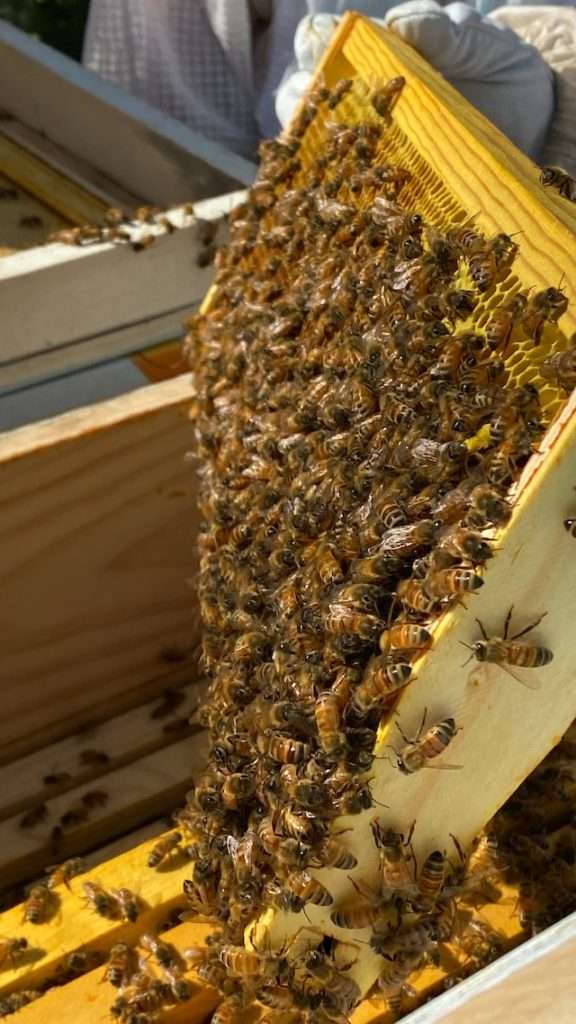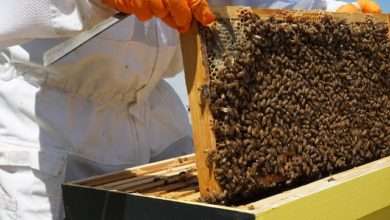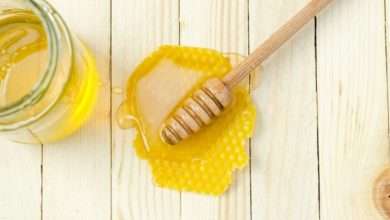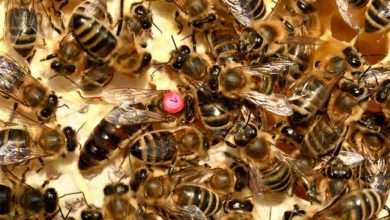What is a Drone Comb Frame?

In the world of beekeeping, drone comb frames are an essential piece of beekeeping equipment. Drone comb frames provide honeybees with essential space to build comfortable beehives and help to regulate a healthy colony size. In addition, proper handling and maintenance of drone comb frames is an important element of beekeeping.
In this article, we’ll discuss what a drone comb frames is and how they are used in beekeeping.
Definition of a Drone Comb Frame
In the world of beekeeping, understanding the various components and structures within the beehive is crucial for successful hive management. One such structure is the drone comb frame.
What is a drone in the context of beekeeping?
In the fascinating universe of bees, a drone refers to the male honeybees that exist within a bee colony. These buzzy fellows can be distinguished from their female counterparts, the worker bees, by their larger size and unique physiology. Drones do not possess stingers, as their main purpose is to mate with a queen to ensure the continuation of their genetic line.
While drones do not participate in typical hive tasks such as foraging for nectar or pollination, they play a crucial role in honeybee colonies. Their primary responsibility is to mate with virgin queens from other colonies, thereby facilitating the genetic diversity and evolution of the honeybee population.
Drones, however, are relatively short-lived compared to worker bees, and their presence within the hive is dependent upon the needs of the colony.
Understanding the comb frame and its purpose
To comprehend the significance of a drone comb frame, we need to first define what a comb frame is. A comb frame, also known as a foundation frame, is a rectangular or square frame that serves as a support structure for the honeycomb within a beehive. It acts as the foundation upon which bees construct their intricate combs.
The combs created by bees are comprised of wax cells that serve a multitude of purposes within the hive. These cells store honey, pollen, and serve as brood cells where eggs are laid and larvae are nurtured. Each comb frame contains a network of these cells, forming the structural backbone of the hive and housing the entire bee community.
So, what makes a drone comb frame different from other comb frames?
Well, as the name suggests, a drone comb frame is specifically designed and dedicated for the purpose of rearing drones. In essence, it is a comb frame that provides a platform solely for drone production.
The construction of drone comb frames involves creating slightly larger cells in comparison to the cells found on worker comb frames. These enlarged cells accommodate the larger size of drone brood, allowing the bees to rear and develop male honeybees with ease.
By designating specific comb frames for drone production, beekeepers can ensure a controlled drone population within the hive.
The drone comb frames are usually positioned towards the outskirts of the beehive, away from the brood area where worker bees are reared. This arrangement aids in better hive management, as beekeepers can easily identify and remove drone comb frames if they wish to control the number of drones present in the colony.
This process, known as drone culling, allows beekeepers to regulate the proportion of drones within the hive according to their management goals.

Understanding the Importance of Drones in Bee Colonies
In the intricate world of bees, various roles and responsibilities are distributed among the different members of a colony. One of the crucial roles in bee colonies is that of the drones.
Drones play a significant part in the reproductive cycle of bees and hold immense importance in maintaining genetic diversity within bee populations. This chapter aims to explore the role of drones in the reproductive cycle and emphasize the significance of genetic diversity in bee colonies.
Explaining the Role of Drones in the Reproductive Cycle of Bees
Drones, often referred to as the male bees, have a specific purpose within the bee colony. Their main responsibility is to mate with the queen bee, ensuring the continuation of the colony’s lineage. Drones are larger in size compared to worker bees and possess distinct characteristics that specifically cater to their reproductive role.
During warm seasons, drones emerge within the colony, ready to fulfill their role in the reproductive cycle. They possess specialized antennae capable of detecting pheromones released by virgin queens, allowing them to locate potential mates. The drone’s anatomical features, such as larger eyes, help in mid-air mating and successfully transferring their genetic material to the queen.
Once a drone successfully mates with a queen bee, its mission is complete. Unfortunately for the drone, this act of reproduction costs it its life. After mating, the drone’s abdomen ruptures, resulting in its death. However, the significance of this sacrifice cannot be undermined, as successful mating leads to the fertilization of the queen’s eggs and the continuation of the colony.
Highlighting the Significance of Genetic Diversity in Bee Populations
The role of drones in maintaining genetic diversity within bee colonies is of critical importance. Genetic diversity is the variation in genetic traits among individuals within a population. It plays a crucial role in ensuring the long-term survival and adaptability of a species, including bees.
When drones mate with the queen, the genetic material they provide is mixed, resulting in genetic diversity among offspring. This genetic diversity is essential for the colony’s resilience to environmental changes, diseases, and parasites. A diverse genetic pool helps bees adapt to different conditions, enhancing their chances of survival.
Genetic diversity also influences various traits in bees, such as overall productivity, resistance to diseases, and efficiency in resource utilization. By promoting genetic diversity, the drones contribute to the overall health and vitality of the colony.
Moreover, genetic diversity ensures a broader gene pool, minimizing the risk of inbreeding, which can lead to weaknesses and vulnerabilities within the population.
Features and Construction of a Drone Comb Frame
In the realm of beekeeping, drone comb frames play a significant role in the success and maintenance of honey bee colonies. These frames are specifically designed to cater to the needs of drones, male bees essential for the survival and reproduction of the colony. In this chapter, we will delve into the features and construction of a drone comb frame, exploring their purpose, differentiation from worker comb frames, and the materials commonly used in their construction.
- Description of the Larger Cell Size in a Drone Comb Frame
One of the distinguishing features of a drone comb frame is the larger cell size it possesses compared to worker comb frames. The cells in a drone comb measure approximately 5.5mm in diameter, as opposed to the relatively smaller 4.9mm cells found in worker comb frames. This size difference serves a specific purpose within the colony.
Drone bees require more space to develop and grow, and thus the larger cell size provides them with ample room for their development. Additionally, these cells serve as storage units for nectar and pollen, ensuring a steady supply of resources for the growing drones.
- Differentiating Drone Comb Frames from Worker Comb Frames
While the larger cell size is a key distinguishing factor, there are additional characteristics that help differentiate drone comb frames from worker comb frames. When examining the comb, you will notice a distinct pattern formed by the larger drone cells amidst the smaller cells of worker brood.
Worker cells tend to be more uniform in size and arrangement, while drone cells create a distinct pattern due to their larger size.
Furthermore, drone comb frames tend to be placed at the periphery of the beehive, often near the bottom.
This strategic positioning allows for efficient mating and reproduction processes as drones emerge from their cells and are ready for their aerial excursions, while still being within close proximity to the queen for mating opportunities. In contrast, worker comb frames are typically closer to the center of the hive, devoted primarily to brood rearing and honey storage.
- Materials Commonly Used to Construct Drone Comb Frames
To ensure the strength and durability of drone comb frames, various materials are commonly used during their construction. The frame itself is typically made from sturdy wood, such as pine or cedar, which provides structural integrity and resistance to bee-related wear and tear.
The wooden frame is then fitted with sheets of foundation wax, often made from beeswax, giving bees a solid base upon which to build their comb.
In recent years, the introduction of plastic foundation sheets has gained popularity among beekeepers. These plastic sheets are textured to mimic the natural cell pattern and offer ease of use and longevity.
However, it is essential to note that while plastic may be a convenient option, some beekeepers still prioritize the use of traditional beeswax foundation, considering it closer to the natural habitat of honey bees.
Placement and Usage of Drone Comb Frames
We will now delve into the importance of properly positioning drone comb frames within the beehive and shed light on the frequency of their usage.
Proper Positioning for Optimal Drone Production
To maximize drone production, beekeepers must ensure the correct placement of drone comb frames within the beehive. Here are some key considerations:
- Location within the Hive: Drone comb frames should be positioned in the upper part of the hive, usually above the honey supers or honey storage boxes. Placing them here prevents drones from interfering with honey storage and allows for better control of drone population.
- Spacing: Maintaining an adequate spacing between drone comb frames is essential. Ideally, beekeepers should leave a gap of at least one or two frames between the drone comb frames. This spacing facilitates easy access for worker bees and prevents crowding, which can hinder optimal beekeeping operations.
- Frame Orientation: When placing drone comb frames, it is essential to ensure that the frames are oriented in the same direction as the other frames in the hive. This alignment assists the bees in building combs more efficiently, optimizing drone brood production.
Frequency of Drone Comb Frame Usage and Its Impact on the Bee Colony
The frequency of using drone comb frames can significantly impact the health and strength of a bee colony. Here are some important insights:
- Strategic Placement: It is advisable for beekeepers to maintain a limited number of drone comb frames within the beehive at any given time. By strategically placing these frames, beekeepers can control the population of drones without overwhelming the hive. This ensures that the bees’ resources are utilized effectively and in balance with the colony’s needs.
- Seasonal Considerations: The frequency of drone comb frame usage may vary depending on the time of year. During the spring and summer seasons, when bee populations peak, beekeepers can increase the number of drone comb frames to meet the natural reproductive requirements of the colony. However, during the fall and winter, when the colony’s focus shifts to survival and honey storage, reducing the number of drone comb frames is advisable.
- Disease Management: Regularly monitoring and managing the health of the bee colony is essential for sustainable beekeeping. Drone comb frames allow for targeted inspection and sampling of the drone brood, enabling early detection of diseases such as Varroa mites or American foulbrood. By promptly identifying and managing these issues, the overall health and productivity of the colony can be safeguarded.
Benefits of Utilizing Drone Comb Frames in Beekeeping
We will now explore the various benefits that drone comb frames offer to beekeepers and how they enhance natural beekeeping methods, facilitate bee breeding and queen rearing processes, as well as increase efficiency in pest and disease management.
- Enhancement of Natural Beekeeping Methods:
Drone comb frames play a vital role in enhancing natural beekeeping methods, particularly in promoting colony health and diversity. By providing designated frames exclusively for drone comb, beekeepers can encourage the natural reproductive behavior of honey bees.
Drones, male bees, play a crucial role in the mating process, and having specific comb frames allows beekeepers to control and manage drone production within the hive. This approach not only mimics the bees’ natural behavior but also ensures a balanced gender ratio within the colony, which is essential for overall hive health.
- Facilitating Bee Breeding and Queen Rearing Processes:
The utilization of drone comb frames greatly facilitates bee breeding and queen rearing processes. Beekeepers who aim to improve specific traits within their colonies, such as docility, disease resistance, or honey production, can benefit from this technique.
By selecting the drone parent, or the male bee, from a genetically desirable hive, beekeepers can increase the chances of passing on desired traits to future generations.
Additionally, these frames enable beekeepers to easily identify and remove drones from colonies with undesirable traits, thus preventing potentially unfavorable mating outcomes. Drone comb frames streamline the process of controlled mating, resulting in colonies with superior qualities and increased productivity.
- Increased Efficiency in Pest and Disease Management:
Pests and diseases pose significant threats to bee colonies worldwide. Effective management and control measures are essential to protect honey bee populations and ensure their long-term survival.
Drone comb frames play a crucial role in this regard by improving efficiency in pest and disease management. These frames provide an opportunity for beekeepers to monitor the health of drones, who are more susceptible to certain diseases, allowing for early detection and intervention.
Additionally, by rotating and replacing drone comb frames regularly, beekeepers can disrupt the reproductive cycles of varroa mites, a notorious pest that affects honey bee colonies. This proactive approach significantly reduces the reliance on chemical treatments, promoting a more sustainable and eco-friendly beekeeping practice.
Limitations and Considerations When Using Drone Comb Frames
It is essential to understand the limitations and considerations associated with the use of drone comb frames.
- Potential Challenges Related to Increased Varroa Mite Infestations
One of the most significant threats faced by honeybee colonies worldwide is the Varroa mite (Varroa destructor). This parasitic mite attaches itself to adult bees and brood, feeding on their hemolymph and transmitting various viruses that can severely impact colony health.
While drone comb frames can be a useful tool for managing drone populations, they also present potential challenges in regards to Varroa mite infestations. Here’s what you need to be aware of:
- Varroa Mite Preference: Varroa mites have a higher preference for drone brood over worker brood due to the increased duration of drone brood cell capping. Drone comb frames provide a conducive environment for Varroa mite reproduction, potentially leading to increased mite infestations within the colony.
- Enhanced Mite Reproduction: Increased drone brood production can result in enhanced Varroa mite reproduction. With more drone cells available, mite populations can grow rapidly, leading to higher infestation levels within the colony.
- Proper Monitoring and Management: It becomes crucial for beekeepers utilizing drone comb frames to implement appropriate monitoring and management techniques to control Varroa mite infestations. Regular assessments, such as sugar roll or alcohol wash tests, and utilization of appropriate mite-control methods are essential to mitigate potential risks.
Effects of Excessive Drone Production on Colony Productivity
The production of drones is a natural process within honeybee colonies. However, excessive drone production can have repercussions on overall colony productivity and resources. When utilizing drone comb frames, it is vital to be mindful of the following considerations:
- Resource Allocation: The production of drones requires significant resources from the colony, including ample amounts of pollen, nectar, and energetic inputs from worker bees. Excessive drone production may strain colony resources and lead to reduced honey production or compromised worker bee health.
- Queen Rearing Competition: An abundance of drones within a colony can cause increased competition during queen rearing. This competition can lead to suboptimal mating opportunities for newly emerged queens, potentially impacting the overall genetic diversity within the colony.
- Supersedure and Swarming: In some instances, excessive drone production can trigger early supersedure or swarming behavior within the colony. Suboptimal mating conditions, due to a surplus of drones, may prompt the colony to replace their queen prematurely or split the colony through swarming, adversely affecting hive stability.
Conclusion
Drone comb frames are an essential part of beekeeping and are necessary for the health and longevity of a honeybee colony.
By providing a comfortable environment for the bees to raise their young, drone comb frames help maintain a healthy, diverse population within the colony. With proper maintenance, drone comb frames can help ensure the continued success of a beekeeping operation.
FAQs
What is a drone comb frame?
- A drone comb frame is a specially designed frame used in beekeeping to encourage the formation of drone bees. It consists of a wooden or plastic frame with larger cell sizes that allow the bees to build drone cells, which are larger than worker bee cells.

Why would I use a drone comb frame?
- Drone comb frames are used by beekeepers for various reasons. Drone bees play an essential role in the reproductive cycle of honey bee colonies, and having an appropriate number of drones is crucial for successful mating and genetics. By using drone comb frames, beekeepers can encourage the production of drones and ensure a balanced population within the colony.
How does a drone comb frame work?
- A drone comb frame provides bees with dedicated space to build drone cells. The frame’s cell size is larger than that of regular honeycomb frames, allowing bees to construct drone-sized cells. By strategically placing these frames within the hive, beekeepers can control the number of drone bees and promote favorable breeding conditions.
Can I use drone comb frames in any beehive?
- Yes, drone comb frames can be used in various hive types, including Langstroth, top bar, and Warre hives. However, it’s important to ensure compatibility with your specific hive model and size. Some hive designs may require modifications or additional equipment to accommodate the drone comb frames.
How many drone comb frames should I use?
- The number of drone comb frames used will depend on the specific goals of the beekeeper. In general, one to two drone comb frames per hive is sufficient to maintain a healthy drone population. However, beekeepers may adjust the number based on factors such as local breeding programs, desired genetics, or specific breeding experiments.
Can I harvest honey or other bee products from drone comb frames?
- Drone comb frames are primarily used for drone production and population management, rather than honey production. Drone bees do not gather nectar or pollen like worker bees, so the drone comb frames may not yield honey for harvesting purposes. However, these frames contribute to the overall health and reproductive success of the colony.
How often should I replace drone comb frames?
- Drone comb frames can be replaced periodically, like other frames in a beehive, to ensure structural integrity and prevent disease buildup. It is recommended to replace drone comb frames at least once a year or as needed. Regular inspection, cleaning, and maintenance of all frames, including drone comb frames, is essential for hive health.
Where can I purchase drone comb frames?
- Drone comb frames are commonly available at beekeeping supply stores, both online and in physical locations. It is recommended to purchase frames specifically designed for your hive model and size. Make sure to choose reputable suppliers who offer high-quality frames to support your beekeeping endeavors.




